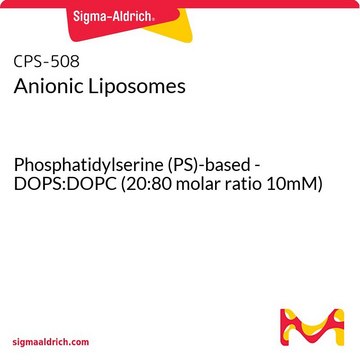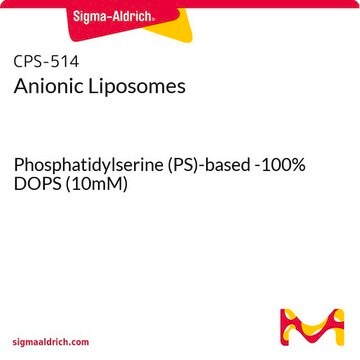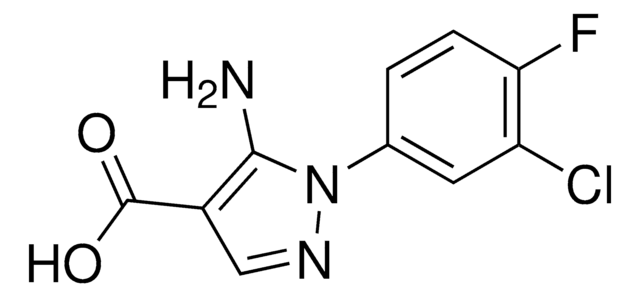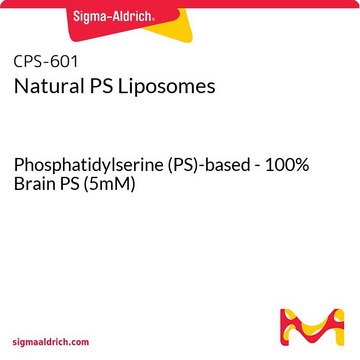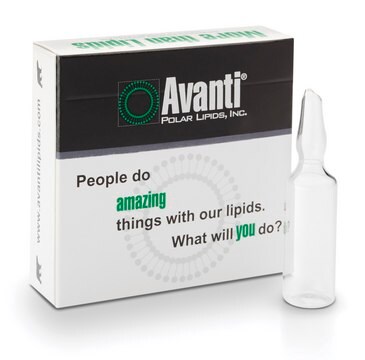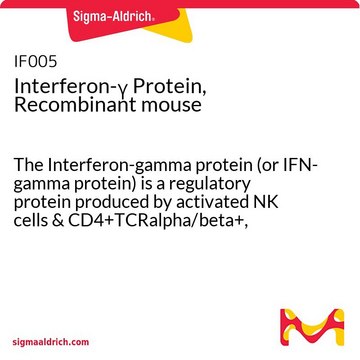LPS-508
Lyophilized Anionic Liposomes - Phosphatidylserine (PS)-based
DOPS:DOPC (20:80 molar ratio)
Zaloguj sięWyświetlanie cen organizacyjnych i kontraktowych
About This Item
Kod UNSPSC:
12352211
NACRES:
NA.23
Polecane produkty
Formularz
lyophilized powder
skład
DOPS:DOPC (20:80 molar ratio)
kolor
white to off-white
średnia wielkość cząstek
100 nm
Szukasz podobnych produktów? Odwiedź Przewodnik dotyczący porównywania produktów
Opis ogólny
Seria liofilizowanych liposomów to liofilizowane liposomy z różnymi rodzajami lipidów i szerokim zakresem potencjałów zeta oraz różnymi właściwościami. Produkty te powinny być stosowane przez naukowców, którzy rozumieją formułowanie liposomów i posiadają odpowiedni sprzęt do sprawdzania wielkości, oddzielania niekapsułkowanych leków i wykonywania odpowiednich testów.
Liposomy są szeroko stosowane do badania interakcji białek, peptydów i innych cząsteczek z powierzchnią błony lipidowej. Jednym z parametrów wpływających na tę interakcję jest ładunek błony liposomalnej. Liposomy są zawsze wytwarzane w środowisku wodnym i mają pożądany rozmiar w stanie ciekłym przy użyciu różnych metod, takich jak wytłaczanie pod wysokim ciśnieniem przez membrany wytrawiające o wielkości nano porów. W rzadkich przypadkach liposomy są liofilizowane, a proliposomy są formowane w obecności liofilizatora, takiego jak trehaloza. Użycie liofilizatora jest konieczne w celu utrzymania rozmiaru liposomów po ponownym uwodnieniu.
Fosfatydyloseryna (PS) jest cząsteczką naładowaną ujemnie. Ilość ujemnego potencjału zeta w liposomach zależy od procentu molowego fosfatydyloseryny (PS) w preparacie. Lipid matrycowy, DOPC, który jest stosowany w preparatach, nie przyczynia się znacząco do ładunku liposomów. Liposomy anionowe są stosowane w badaniach dopełniacza krwi i różnego rodzaju badaniach in vitro.
Liposomy są szeroko stosowane do badania interakcji białek, peptydów i innych cząsteczek z powierzchnią błony lipidowej. Jednym z parametrów wpływających na tę interakcję jest ładunek błony liposomalnej. Liposomy są zawsze wytwarzane w środowisku wodnym i mają pożądany rozmiar w stanie ciekłym przy użyciu różnych metod, takich jak wytłaczanie pod wysokim ciśnieniem przez membrany wytrawiające o wielkości nano porów. W rzadkich przypadkach liposomy są liofilizowane, a proliposomy są formowane w obecności liofilizatora, takiego jak trehaloza. Użycie liofilizatora jest konieczne w celu utrzymania rozmiaru liposomów po ponownym uwodnieniu.
Fosfatydyloseryna (PS) jest cząsteczką naładowaną ujemnie. Ilość ujemnego potencjału zeta w liposomach zależy od procentu molowego fosfatydyloseryny (PS) w preparacie. Lipid matrycowy, DOPC, który jest stosowany w preparatach, nie przyczynia się znacząco do ładunku liposomów. Liposomy anionowe są stosowane w badaniach dopełniacza krwi i różnego rodzaju badaniach in vitro.
Zastosowanie
- Liposomy powstają po uwodnieniu liofilizowanego preparatu. Jeśli liofilizowane liposomy zostaną uwodnione roztworem zawierającym lek rozpuszczalny w wodzie, wówczas duży procent leku pozostanie poza liposomami i w postaci niekapsułkowanej. Zaleca się użycie kasety do mikrodializy lub kolumny wirówkowej przy użyciu kulek po prawej stronie (w zależności od wielkości leku) i oddzielenie liposomów otoczonych lekiem od wolnego leku oraz wykonanie oznaczenia leku w celu obliczenia skuteczności otoczkowania.
- Liofilizowane liposomy są głównie zalecane do stosowania z lekami, które mają krótki czas życia w roztworze wodnym, głównie z powodu hydrolizy. Po dodaniu roztworu leku do liofilizowanych liposomów należy je natychmiast zużyć.
- Liofilizowane produkty liposomowe powinny być stosowane przez naukowców, którzy rozumieją formułowanie liposomów i mają odpowiedni sprzęt do sprawdzania wielkości, oddzielania niekapsułkowanego leku i wykonywania odpowiednich testów.
- Trehaloza jest stosowana jako liooprotektant we wszystkich liofilizowanych preparatach liposomowych. Rozkład wielkości po uwodnieniu liofilizowanego preparatu będzie wynosił około 100 nm.
- Liofilizowane liposomy powinny być przechowywane w temperaturze -20°C.
Ta strona może zawierać tekst przetłumaczony maszynowo.
Kod klasy składowania
13 - Non Combustible Solids
Klasa zagrożenia wodnego (WGK)
WGK 3
Temperatura zapłonu (°F)
Not applicable
Temperatura zapłonu (°C)
Not applicable
Wybierz jedną z najnowszych wersji:
Certyfikaty analizy (CoA)
Lot/Batch Number
It looks like we've run into a problem, but you can still download Certificates of Analysis from our Dokumenty section.
Proszę o kontakt, jeśli potrzebna jest pomoc Obsługa Klienta
Masz już ten produkt?
Dokumenty związane z niedawno zakupionymi produktami zostały zamieszczone w Bibliotece dokumentów.
Nasz zespół naukowców ma doświadczenie we wszystkich obszarach badań, w tym w naukach przyrodniczych, materiałoznawstwie, syntezie chemicznej, chromatografii, analityce i wielu innych dziedzinach.
Skontaktuj się z zespołem ds. pomocy technicznej


